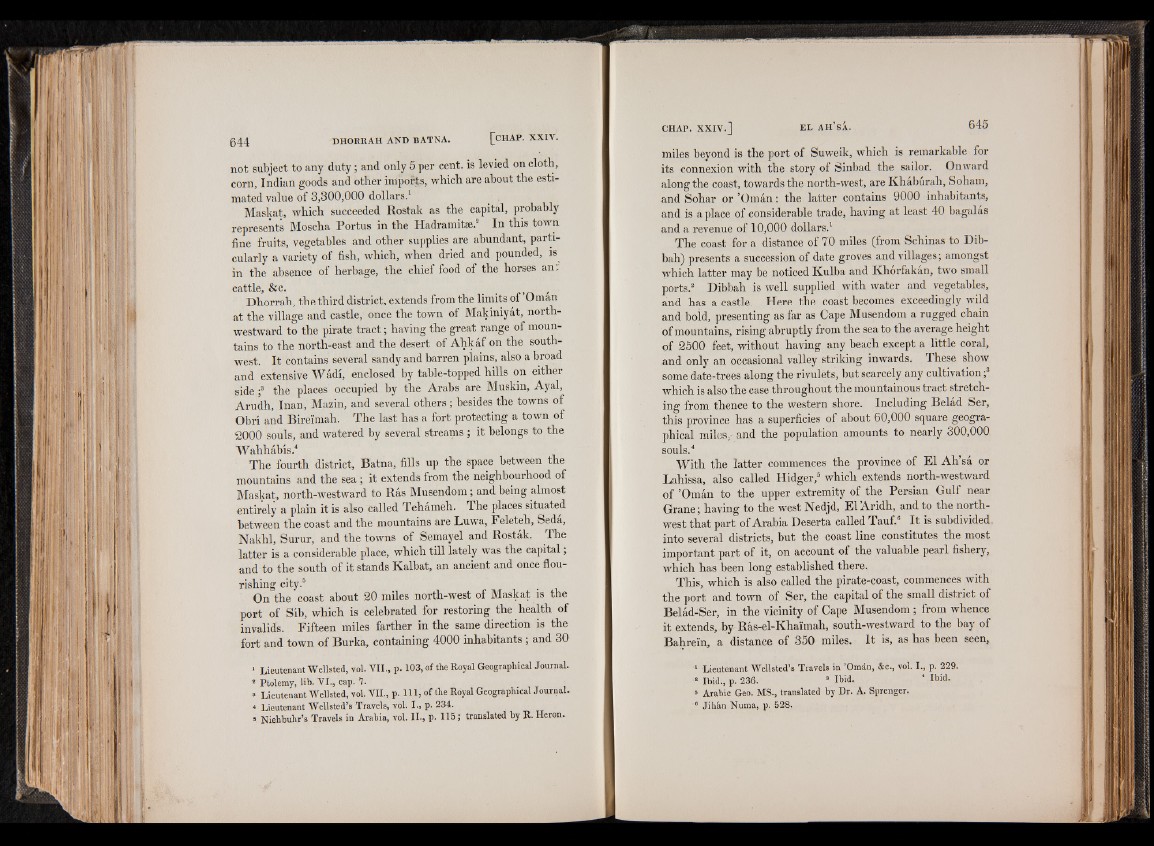
not subject to any duty; and only 5 per cent, is levied on cloth,
corn, Indian goods and other imports, which are about the estimated
value of 3,300,000 dollars.1
Maskat, which succeeded Rostak as the capital, probably
represents Moscha Portus in the Hadramitse.2 In this town
fine fruits, vegetables and other supplies are abundant, particularly
a variety of fish, which, when dried and pounded, is
in the absence of herbage, the chief food of the horses an.
cattle, &c. /
Dhorrah, the third district, extends from the limits of Oman
at the village and castle, once the town of Makiniyat, northwestward
to the pirate tract; having the great range of mountains
to the north-east and the desert of Ahkaf on the southwest.
It contains several sandy and barren plains, also a broad
and extensive Wadi, enclosed by table-topped hills on either
side ;3 the places occupied by the Arabs are Muskin, Ayal,
Arudh, Inan, Mazin, and several others; besides the towns of
Obri and Bire'imah. The last has a fort protecting a town of
2000 souls, and watered by several streams ; it belongs to the
Wahhabis.4
The fourth district, Batna, fills up the space between the
mountains and the sea ; it extends from the neighbourhood of
Maskat, north-westward to Ras Musendom; and being almost
entirely a plain it is also called Tehameh. The places situated
between the coast and the mountains are Luwa, Feleteh, Seda,
Nakhl, Surur, and the towns of Semayel and Rostak. The
latter is a considerable place, which till lately was the capital,
and to the south of it stands Kalbat, an ancient and once flourishing
city.6
On the coast about 20 miles north-west of Maskat is the
port of Sib, which is celebrated for restoring the health of
invalids. Fifteen miles farther in the same direction is the
fort and town of Burka, containing 4000 inhabitants ; and 30
1 Lieutenant Wellsted, vol. VII., p. 103, of the Royal Geographical Journal.
* Ptolemy, lib. VI., cap. 1.
a Lieutenant Wellsted, vol. VII., p. I l l , of the Royal Geographical Journal.
‘ Lieutenant Wellsted’s Travels, vol. I., p. 234.
5 Niehhuhr’s Travels in Arabia, vol. II., p. 115; translated by R. Heron.
miles beyond is the port of Suweik, which is remarkable for
its connexion with the story of Sinbad the sailor. Onward
along the coast, towards the north-west, are Khaburah, Soham,
and Sohar or ’Omán: the latter contains 9000 inhabitants,
and is a place of considerable trade, having at least 40 bagalás
and a revenue of 10,000 dollars.1
The coast for a distance of 70 miles (from Schinas to Dib-
bah) presents a succession of date groves and villages; amongst
which latter may be noticed Kulba and Khorfakan, two small
ports.2 Dibbah is well supplied with water and vegetables,
and has a castle. Here the coast becomes exceedingly wild
and bold, presenting as far as Cape Musendom a rugged chain
of mountains, rising abruptly from the sea to the average height
of 2500 feet, without having any beach except a little coral,
and only an occasional valley striking inwards. These show
some date-trees along the rivulets, but scarcely any cultivation;
which is also the case throughout the mountainous tract stretching
from thence to the western shore. Including Belad Ser,
this province has a superficies of about 60,000 square geographical
miles,- and the population amounts to nearly 300,000
souls.4
With the latter commences the province of El Ah’sá or
Lahissa, also called Hidger,5 which extends north-westward
of ’Omán to the upper extremity of the Persian Gulf near
Grane; having to the west Nedjd, El Aridh, and to the northwest
that part of Arabia Deserta called Tauf.6 It is subdivided,
into several districts, but the coast line constitutes the most
important part of it, on account of the valuable pearl fishery,
which has been long established there.
This, which is also called the pirate-coast, commences with
the port and town of Ser, the capital of the small district of
Belád-Ser, in the vicinity of Cape Musendom ; from whence
it extends, by Ras-el-Kha’imah, south-westward to the bay of
Bahrein, a distance of 350 miles. It is, as has been seen,
1 Lieutenant Wellsted’s Travels in ’Omán, &c., vol. I„ p. 229.
* Ibid., p. 236. 3 Ibid. 4 Ibid.
5 Arabic Geo. MS., translated by Dr. A. Sprenger.
6 Jihkn Numa, p. 528.